Move over parsley – microgreens are shaking things up! These tiny greens have been adorning restaurant plates for several years now, but did you know that there is a lot more you can do with them than just dressing up your plate?
A few weeks ago I had an opportunity to do a taste test of a variety of microgreens from the Aerofarms company. I received 7 packets of different flavors of microgreens from them to use during our tasting. I have to tell you, the flavors were amazing.
Each pack was filled with different greens. We tried:
- Micro kale
- Micro broccoli
- Micro arugula
- Wasabi mustard
- Spicy mix
- Rainbow mix
- Micro super mix
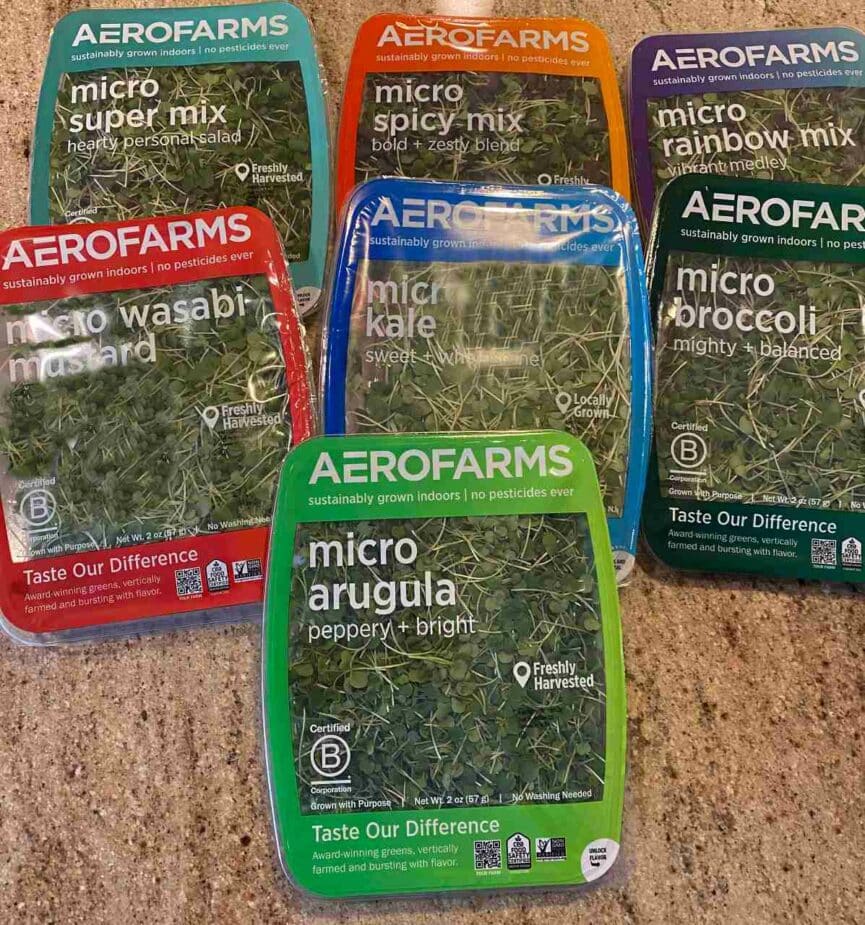
Each variety had a unique flavor and bright, gorgeous colors. The packaging is color-coded to help you know if you are treading into spicy land or staying in the land of mild and delicious flavors.
By far, my favorite was the broccoli microgreens. They are mild enough to eat right out of the package but also work well in almost any recipe you can dream up!
I thought I’d share some of what I learned about broccoli microgreens and how I like using them.
Table of Contents
What are Broccoli Microgreens?
So let’s start at the beginning. What exactly are broccoli microgreens? Broccoli microgreens are the first shoots of broccoli after planting. They are the immature shoots of a broccoli plant. They’re small and tender, only about 1-3 inches tall. They have just a couple of little green leaves at the top.
These baby greens are full of nutrients – typically much more than what is in the fully grown plant, making them a nutritious option and an easy way to eat more vegetables. You can use broccoli microgreens in salads, sandwiches, or as a garnish for other dishes.
Broccoli microgreens are easy to grow and are ready for harvest after only 10 days. They take up very little space and can be grown outside or indoors. You can grow them on your windowsill at home or purchase them at the store.
They’re also easy to grow at home. You can have a variety growing on your windowsill.
What do broccoli microgreens taste like?
Broccoli microgreens have a flavor that’s similar to mature broccoli, but milder and less bitter. Some people describe the taste as slightly nutty or earthy, with a hint of sweetness. I found them to be mild but they still had a little “bite” to them. The little shoots are tender and delicate, with a crisp, slightly crunchy texture.
What is the difference between broccoli microgreens and broccoli?
The main difference between broccoli microgreens and broccoli is their growing stage. Microgreens are the small shoots of the broccoli plant that are harvested shortly after planting. The shoots start to appear and after about 7 – 10 days they are 2 – 3 inches tall with a couple of tiny green leaves at the top. Once those green leaves appear, they are ready to harvest.
Broccoli, on the other hand, is a mature plant that is enjoyed for its edible flower buds and thick stems. The mature broccoli plant typically takes several weeks or even months to grow and produce its characteristic green florets.
What is the difference between broccoli microgreens and broccoli sprouts?
The key difference between broccoli microgreens and broccoli sprouts is how far along each plant is in the growing process.
Broccoli sprouts are the shoots from the broccoli seed and include the broccoli seed. They don’t have any leaves yet and are typically ready to eat in just a few days of soaking. Broccoli sprouts are not grown in soil. They are soaked in water and left to sprout.
Broccoli microgreens however are grown in soil and are clipped off above the soil line once the little green leaves appear on the top of the plant. You only eat the greens and little stems, not the seed. They are ready to eat about 7 – 10 days after planting.
Broccoli Microgreens Nutrition
Broccoli is a member of the plant family called the Brassicaceae family. This group of plants includes cauliflower, cabbage, Brussels sprouts, kale, and arugula. These veggies are known for their powerful nutrition content and many health-promoting effects.
The good news is that broccoli microgreens have many of the same nutrients, just in much higher concentrations per serving.
These little greens may be tiny but they are pretty powerful. According to the AeroFarms company, their broccoli microgreens contain 5 X more vitamins and carotenoids than the full-grown broccoli plant. While you can grow microgreens at home, there is some data that suggests growing them in a controlled environment like the AeroFarms facility may improve their nutrient content.1
With that said, homegrown microgreens are still a great source of nutrition. A recent study that looked at homegrown broccoli microgreens also found higher levels of many minerals including calcium, potassium, iron, and zinc than the full-sized broccoli plant.2
One of the key nutrients found in broccoli is sulforaphane. This nutrient has been widely studied for its antioxidant and anticancer properties and has been found in high concentrations in both broccoli microgreens and broccoli sprouts. Other nutrients including carotenoids like beta-carotene have also been found in high concentrations in both broccoli microgreens and broccoli sprouts.3
Health Benefits of Broccoli Microgreens
Eating more fruits and vegetables that are full of antioxidants and carotenoids is an important way to support your health and reduce the risk of chronic disease. While there isn’t much research yet on the specific broccoli microgreens benefits, we do know that many of the nutrients found in them may have health protective effects.
Heart Disease
Microgreens are a good source of vitamin C, and carotenoids including beta-caroteine and lutein, and may be up to five times higher than their adult counterparts.4 Studies have shown that getting plenty of nutrient-rich greens in your diet can lower your risk of heart disease and stroke.5 So why not add some of these delicious little greens to your meals?
Brain Health
This is an important one for me! In the MIND Diet, an eating style that has been shown to reduce the risk of Alzheimer’s disease and dementia, dark leafy greens are one of the most important foods to eat. As a matter of fact, a recent study confirmed that dark leafy greens have been shown to be one of the most important vegetables to include in your diet to reduce the risk of Alzheimer’s disease and delay the onset of dementia.6
So, that begs the question, how do microgreens fit? Since these baby greens have at least as much (if not more) of the brain-boosting nutrients as their mature counterparts, it leads us to believe that these baby greens may also help support your brain health.
Some Types of Cancers
Eating more fruits and vegetables that are rich in carotenoids and antioxidants has been associated with a reduced risk of developing certain types of cancer so it makes sense that adding these powerful little greens that pack a powerful nutrient punch to your diet may help reduce your risk of developing some types of cancer too.
Eye Health
Broccoli microgreens are a good source of the carotenoids lutein and zeaxanthin that are important for your eyes. Lutein and zeaxanthin have been shown to help reduce the risk of age-related macular degeneration and may help reduce cataract formation
Gut health
The carotenoid and polyphenol content of these little greens may help your GI tract too. These nutrients are thought to be protective against inflammation and that translates to your GI tract as well.8 More research is needed but including microgreens as part of an overall healthy diet is a no-brainer.
Good for your skin and hair
Let’s be honest, healthy skin and hair make us feel good! But beyond that, our skin is the largest organ in our body. It helps protect us from harmful environmental elements and keeps us looking youthful and radiant.
The good news is that microgreens might be able to do wonders for our skin too! All those antioxidants and carotenoids may help shield us from harmful UV rays reducing our risk of skin cancer and signs of aging.9
But that’s not all! Microgreens are filled with vitamin C which helps boost collagen formation that helps to keep wrinkles at bay (or at least lessens them!). Plus, other essential minerals like zinc and copper found in microgreens can support the growth of new skin cells and keep our skin’s structure strong and healthy.9
Are there any Side Effects from Eating Broccoli Microgreens?
Broccoli microgreens are perfectly safe for most people to eat. Like other raw plants, it is important to keep food safety in mind. Microgreens that are sold in your local grocery store and come prepackaged are often grown indoors under very controlled conditions. They also are required by law to follow “Good Manufacturing Processes.”
Many of these are pre-washed so you don’t need to wash them before using them. The package will tell you if they are safe to eat and if in doubt, it’s always best to run them under cool water and dry them either in a salad spinner or on a clean paper towel.
When growing them at home or if you purchase them loose from a grocery store or farmer’s market, there are certain food safety measures you will want to take to make sure your microgreens are clean and safe.
As you would with other fresh produce, you should wash microgreens before eating them. Rinse them under cool water right before eating and then dry them in a salad spinner or on a clean paper towel before using them.
How to Grow Broccoli Microgreens
One of the best things about microgreens is that they are easy to grow at home, and broccoli microgreens are one of the easiest to grow. You can grow them on your windowsill throughout the year, and they grow quickly so you have a nutritious vegetable ready to eat in a little over a week. Before growing broccoli microgreens there are a few things to keep in mind:
- Do you have a mostly sunny spot to grow the microgreens? They should get at least 4-6 hours of sunlight a day.
- If you don’t have a sunny location, a grow light will help. You can get a small grow light for about $16 on Amazon. (Affiliate Link)
- Will you be around for the 10 days it will take to grow? They don’t need a lot of maintenance but will need at least a daily spray of water. It’s probably best not to plan a long weekend away right after planting!
Equipment needed to grow microgreens
Other than light, a little water, and the broccoli microgreen seeds there is very little equipment that is needed to grow these little guys. You need:
- Potting soil
- A container that will hold about 2 inches of soil and has drainage holes, or that you can poke holes in for drainage. Think of an aluminum pie plate, a clear plastic container, or a small clay pot. Any of those will work.
- A second container without holes for the seed container to sit in.
- Good quality seeds – most garden centers will have them or you can look online for quality gardening websites.
- A spray bottle
- Sharp scissors
How to plant broccoli microgreens
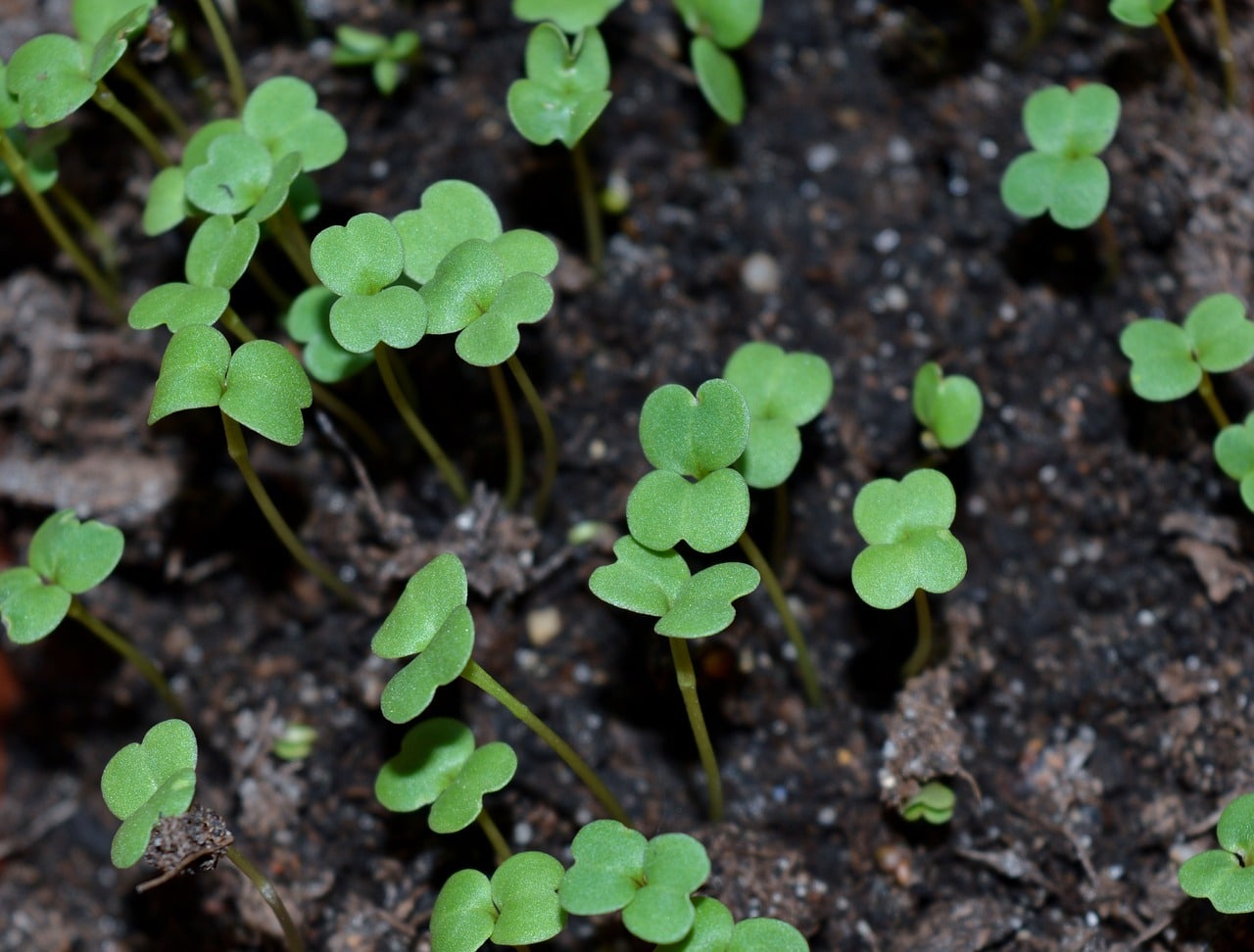
- First, fill your seed container or planting tray to the rim with the potting soil and place it in the second container.
- Lightly spray the soil with water to get the soil wet, but not soaked.
- Then, spread the broccoli seeds on top of the soil, covering as much as possible but not overlapping the seeds. Leave them on top of the soil. They don’t need to be buried. Spray them with water to get them wet.
- Now, cover the container with a larger tray. This will keep the moisture in the soil and allow the seeds to germinate. Keep them covered for about 2 days. Check them to see if they have started to sprout. If not, make sure they are still damp and recover them. You can spray them lightly if they feel like they are drying out.
- Once they start to sprout, remove the cover and place the under the light or in the sunlight and watch them start to grow. To water them, it’s best to add water to the container on the bottom. The soil will it up from the bottom which will prevent the greens from getting too wet and developing mold.
- Once they reach about 2-3 inches and you see 2 true leaves form (called cotyledon leaves) they are ready to harvest.
- Using sharp scissors, cut the greens right above the soil surface.
How are they grown commercially?
Since these little greens are fast growing and take up such little space, many businesses are sprouting up all the time. See what I did there? But seriously, they are an easy crop to grow and can be grown indoors, they can be grown and harvested year-round.
One way is called vertical farming. This really means that trays of crops are stacked on racks on top of each other. A lot of crops can be grown in a very small area. Everything is controlled including the lighting, soil or growing medium, fertilizer, moisture, humidity, and airflow.
The companies use technology to monitor all the systems and the plants to know exactly when to harvest them for the best results.
Many companies have strong quality control systems and work with independent agencies to monitor their safety standards.
For farmers who grow microgreens for local retailers, CSAs, or Farmer’s markets they are typically grown in greenhouses or other protected structures.
Where can you buy microgreens?
Broccoli microgreens are available at many large grocery stores and retail chains. You may also be able to find them at your local farmer’s market or through a CSA.
How to Store your broccoli microgreens
It is best to keep your microgreens in a sealed container in the bottom part of your refrigerator or in your vegetable drawer. They should last 5 days if stored correctly.
How to Use Broccoli Microgreens
So what can you do with broccoli microgreens, besides sprinkling them on top of your fancy dinner? Here are a few ideas to get your taste buds tingling:
- Add them to your morning smoothie
- Toss them with your salad
- Add them to a soup
- Mix them into your scrambled eggs
- Put them in a sandwich
- Top your avocado toast with them
- Add them on top of hummus
- Mix them into chicken or tuna salad
- Top your pizza with them
If you decide to cook with them, keep in mind that heating them will likely decrease some of the nutrient content so it’s best to try to add them toward the end of cooking to minimize the loss.
What other foods go well with broccoli microgreens
Have you ever heard that what grows together goes together? It’s true and is a good guide to follow when figuring out how to use broccoli microgreens. According to some gardening websites, other vegetables that grow well near broccoli include peas, potatoes, and some herbs like mint and basil.
Recipes using broccoli microgreens
So what are some of my favorite ways to eat broccoli microgreens? I love tossing them in sandwiches and salads, but since having the opportunity to try so many different varieties (and not wanting to waste them!) I’ve been playing around with them.
This easy spring salad is one of my favorites so far. Just a mix of power greens, green beans, spring peas, asparagus, radishes, and broccoli microgreens with a zesty green goddess dressing. Toss in a little feta cheese or enjoy it as a side salad for dinner.
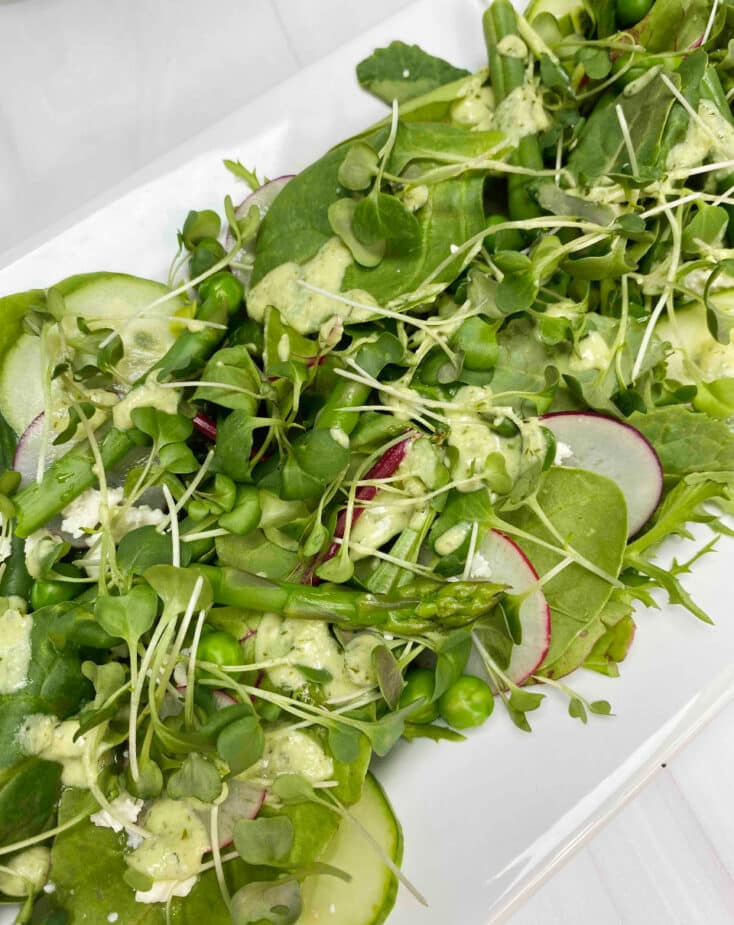
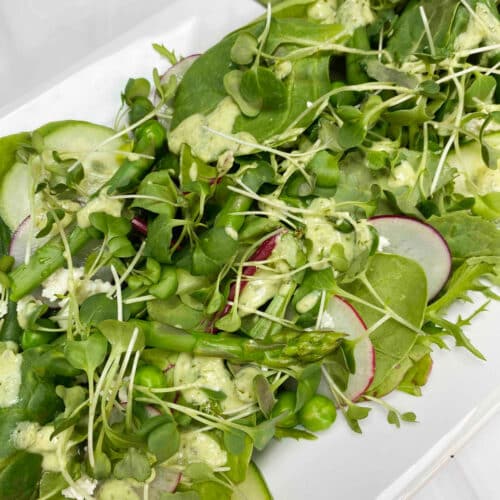
Spring Salad with Broccoli Microgreens
Ingredients
- 4 cups power greens
- ½ cup asparagus spears cut into 2 inch pieces
- ½ cup french green beans cut into 2 inch pieces
- ½ cup spring peas or frozen peas
- 2 radishes thinly sliced
- ¼ cup thinly sliced English cucumber
- ¼ cup Green goddess dressing
- ¼ cup crumbled feta cheese
- 1 cup broccoli microgreens
Instructions
- Fill a medium saucepan with water and bring it to a boil. Add the green beans and peas and boil for 3 minutes. Add the asparagus spears and continue to boil for 2 minutes. Drain into a colander and run cold water over the vegetables to cool them quickly. Set aside.
- Place greens on a large platter. Top with sliced radishes and cucumbers. Add the cooked vegetables and toss.
- Drizzle with green goddess dressing.
- Sprinkle the salad with the feta cheese and top with the broccoli microgreens.
Nutrition
Keep an eye on my blog as I know I’ll be adding more recipes soon.
Other types of microgreens to try?
There are a variety of microgreens available. Common varieties that you’ll see in many grocery stores are kale and arugula microgreens but you may also find others at your local farmer’s market too. And of course, you can always try your hand at growing your own too, and experiment with different types. Radish and arugula are common microgreens as they are easy to grow and in the spring you may also find watercress microgreens.
I was also able to try the wasabi mustard microgreens from Aerofarms and, yes, they tasted just like Wasabi. I added those to some spring rolls I made one weekend and they gave them just a hint of wasabi flavor…and looked beautiful through the rice paper!
FAQs
Broccoli microgreens have a light, slight broccoli flavor. They are a little “earthy” and may have a little “bite” but overall have a mellow but bright flavor and a slightly crunchy texture.
Unfortunately no. Once you clip off the microgreen at the surface of the soil the seed will die. But you can plant over them. Just put a fresh layer of seeds down and start at the beginning.
You do not need soil to grow microgreens. You can buy a seeding mat or even just a clean, damp paper towel.
Microgreens require significantly less water to grow than growing mature plants which is another benefit. It has been estimated that broccoli microgreens require 158 – 236 times less water than a nutritionally equivalent mature broccoli plant to grow. [SOURCE]
Final Thoughts
With their versatility and delicious flavor, broccoli microgreens are a great way to spice up your meals. Their nutritional and potential health benefits are just an added bonus!
If you have never tried microgreens, broccoli microgreens are an ideal place to start. They are so mild that you can eat them right out of the package. But take a look at the ideas above and start by just adding a handful to your sandwich or salad.
Let me know if you give them a try, what you thought and how you used them in the comments below!
References
1 Liu, A., Shi, J., Wan, J., Pham, Q., Zhang, Z. Sun, J., Yu, L., Luo, Y., Want., T. (2022). Profiling of Polyphenols and glucosinolates in kale and broccoli microgreens grown under chamber and windowsill conditions by ultrahigh-performance liquid chromatography high-resolution mass spectrometry. ACS Food Sci. Technol. 2(1): 101-113. https://pubs.acs.org/doi/10.1021/acsfoodscitech.1c00355#
2 Weber C. F. (2017). Broccoli Microgreens: A Mineral-Rich Crop That Can Diversify Food Systems. Frontiers in nutrition, 4, 7. https://doi.org/10.3389/fnut.2017.00007
3 Le, T. N., Chiu, C. H., & Hsieh, P. C. (2020). Bioactive Compounds and Bioactivities of Brassica oleracea L. var. Italica Sprouts and Microgreens: An Updated Overview from a Nutraceutical Perspective. Plants (Basel, Switzerland), 9(8), 946. https://doi.org/10.3390/plants9080946
4 USDA, Agricultural Research Services Archive. “Specialty Greens Pack a Nutritional Punch.” January 2014. Accessed April 15, 2023. https://agresearchmag.ars.usda.gov/2014/jan/greens
5 Aune, D., Giovannucci, E., Boffetta, P., Fadnes, L.T., Keum, N., Norat, T. Greenwood, D.C., Riboli, E., Vatten, L.J., Tonstad, S. (2017). Fruit and vegetable intake and the risk of cardiovascular disease, total cancer and all-cause mortality—a systematic review and dose-response meta-analysis of prospective studies, International Journal of Epidemiology, 46(3):1029–1056, https://doi.org/10.1093/ije/dyw319
6 Morris, M. C., Tangney, C. C., Wang, Y., Sacks, F. M., Bennett, D. A., & Aggarwal, N. T. (2015). MIND diet associated with reduced incidence of Alzheimer’s disease. Alzheimer’s & dementia: the journal of the Alzheimer’s Association, 11(9), 1007–1014. https://doi.org/10.1016/j.jalz.2014.11.009
7 Mares J. (2016). Lutein and Zeaxanthin Isomers in Eye Health and Disease. Annual review of nutrition, 36, 571–602. https://doi.org/10.1146/annurev-nutr-071715-051110
8 Alloggia, F. P., Bafumo, R. F., Ramirez, D. A., Maza, M. A., & Camargo, A. B. (2023). Brassicaceae microgreens: A novel and promissory source of sustainable bioactive compounds. Current research in food science, 6, 100480. https://doi.org/10.1016/j.crfs.2023.100480
9 Michalak, M., Pierzak, M., Kręcisz, B., & Suliga, E. (2021). Bioactive Compounds for Skin Health: A Review. Nutrients, 13(1), 203. https://doi.org/10.3390/nu13010203
10 Weber C. F. (2017). Broccoli Microgreens: A Mineral-Rich Crop That Can Diversify Food Systems. Frontiers in nutrition, 4, 7. https://doi.org/10.3389/fnut.2017.00007

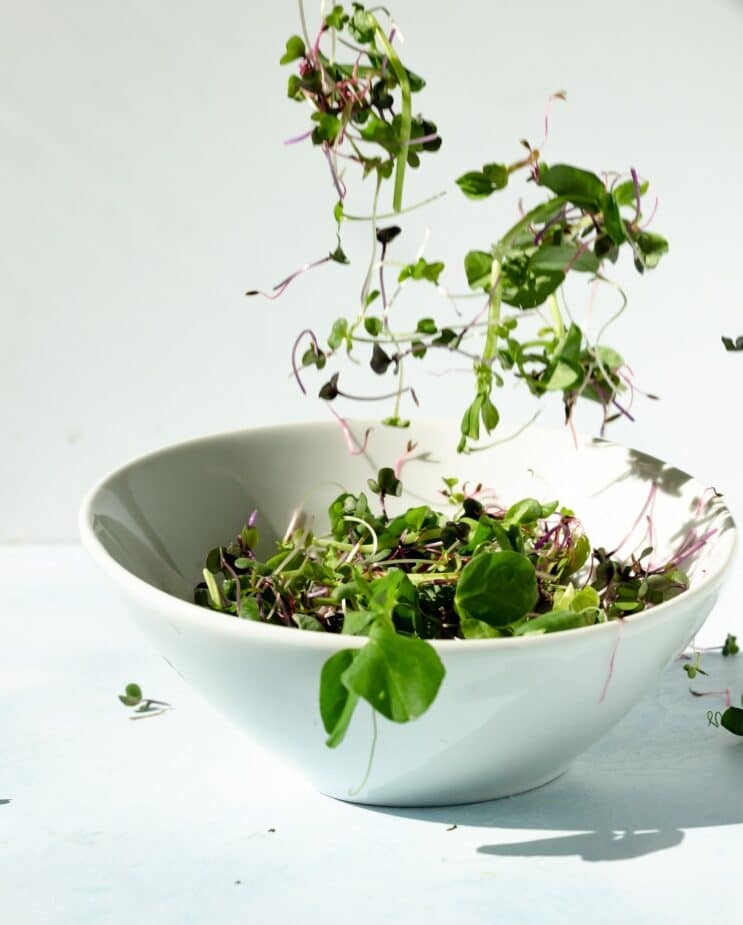

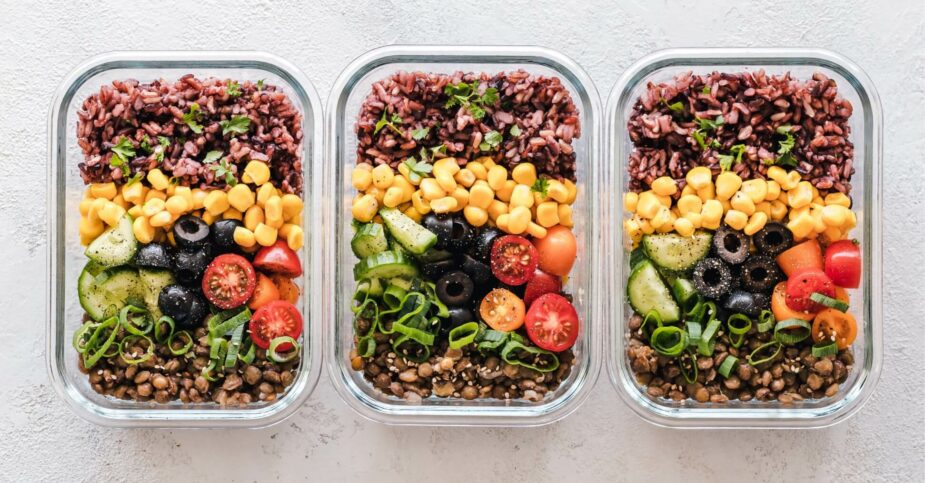
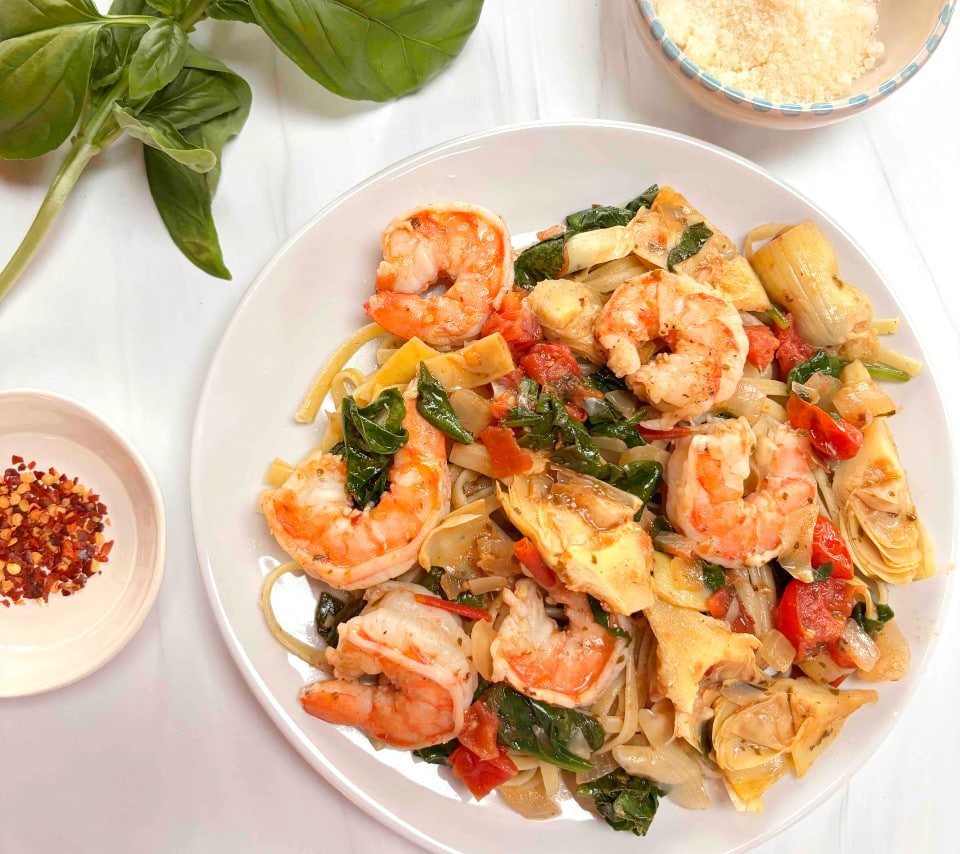
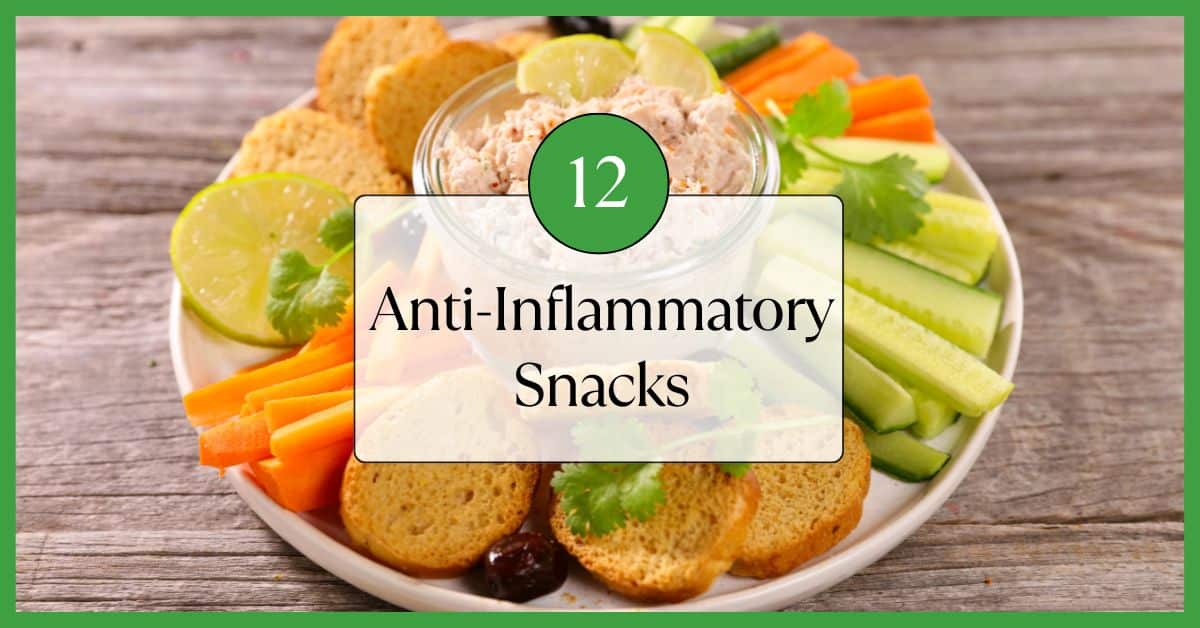
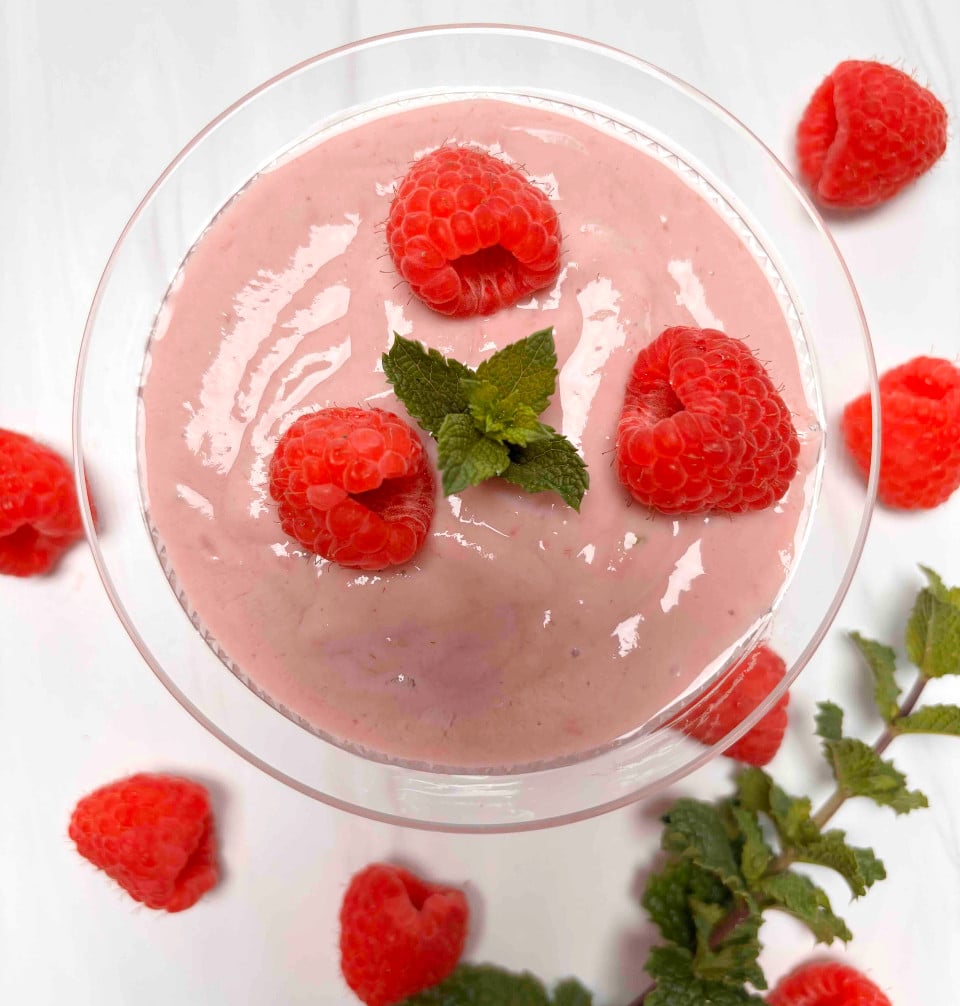

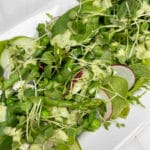
6 thoughts on “Broccoli Microgreens: All You Need to Know”
I would like to grow Grow Broccoli Microgreens at home.
Could you provide a reputable merchant so I may begin?
Hi Ron, I’ve always been a fan of Burpee seeds https://www.burpee.com/vegetables/microgreens/ True Leaf Market also has a good variety of microgreens seeds. If you want step by step directions for how to grow them safely, Penn State Extension is a great resource. https://extension.psu.edu/a-step-by-step-guide-for-growing-microgreens-at-home I hope this helps you get started! Laura
Hi, Im a microgreen farmer in Oklahoma. Im growing my social media and I recently found your article on broccoli microgreens. Do you mind if I share some of your article on a social media post? I found your data to be very well documented and organized. I would of course site your work. Thanks in advance and let me know your thoughts.
Sincerly
Kathryn
Hi Kathryn, Thanks for reaching out. Of course and thank you for asking! Laura
Once they reach about 2-3 inches and you see 2 true leaves form (called cotyledon leaves) they are ready to harvest.
Cotyledon leaves are the leaves before the true leaves
I was looking for information on the nutritional value of sprouts vs microgreens
Thanks Peggy, I’ll definitely consider adding a section on this the next time I update this post. What I have found is that both broccoli sprouts and broccoli microgreens contain the same nutrients as the full grown vegetable and, depending on how they are grown, may contain more of some vitamins and minerals. Vitamin C, potassium, magnesium and zinc tend to be found in higher quantities in both forms as well as some antioxidants. I’ll add more to this when I do my next update. Thanks for reading and your question.